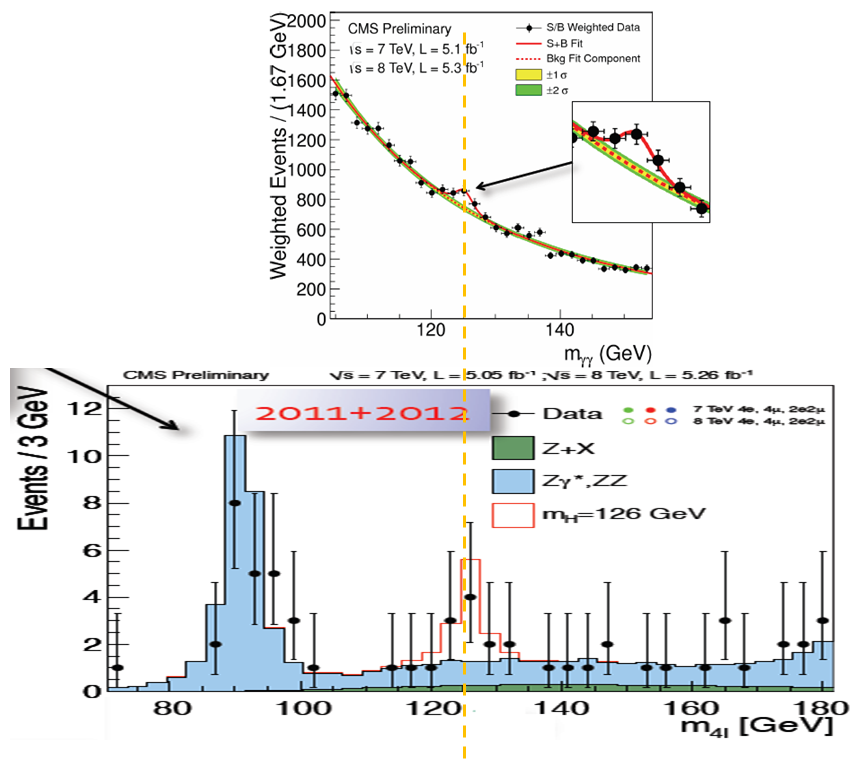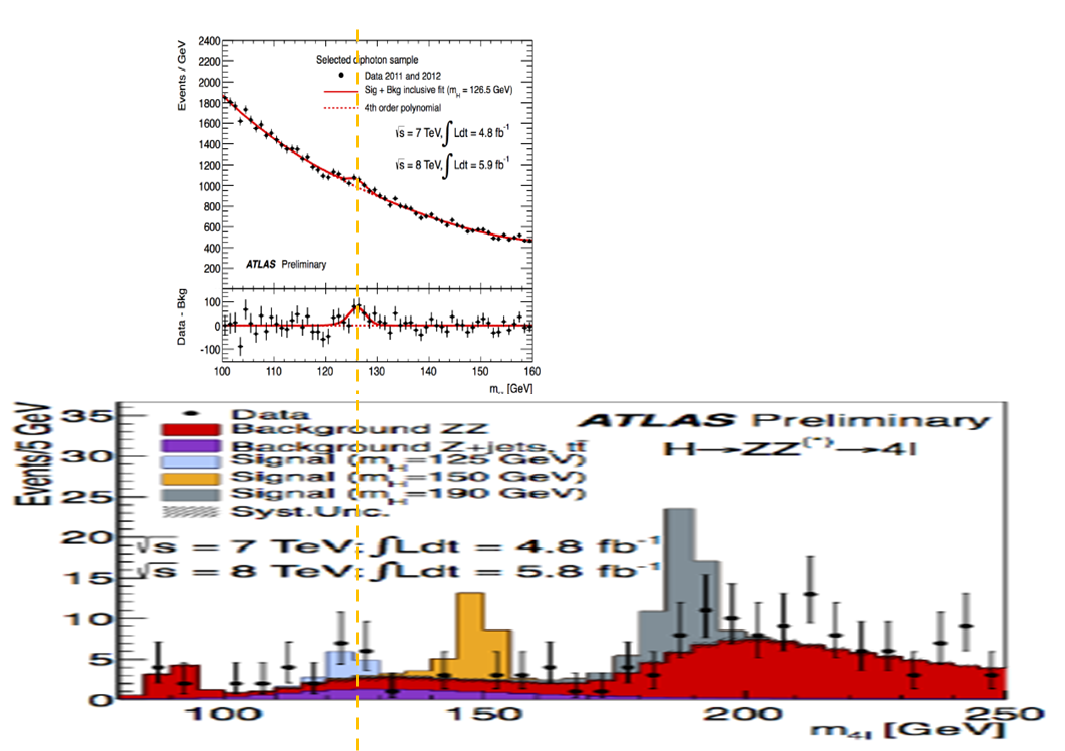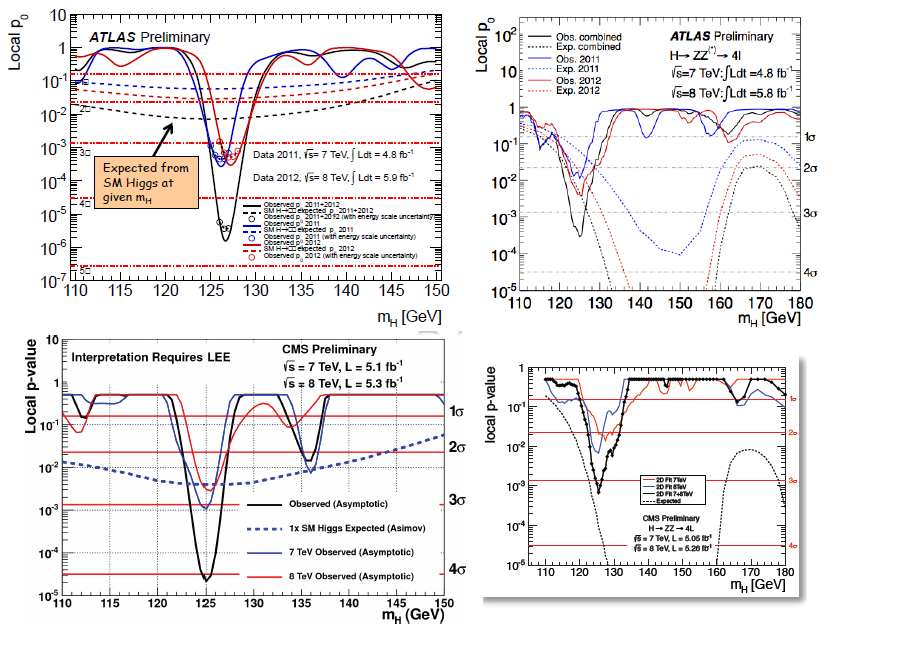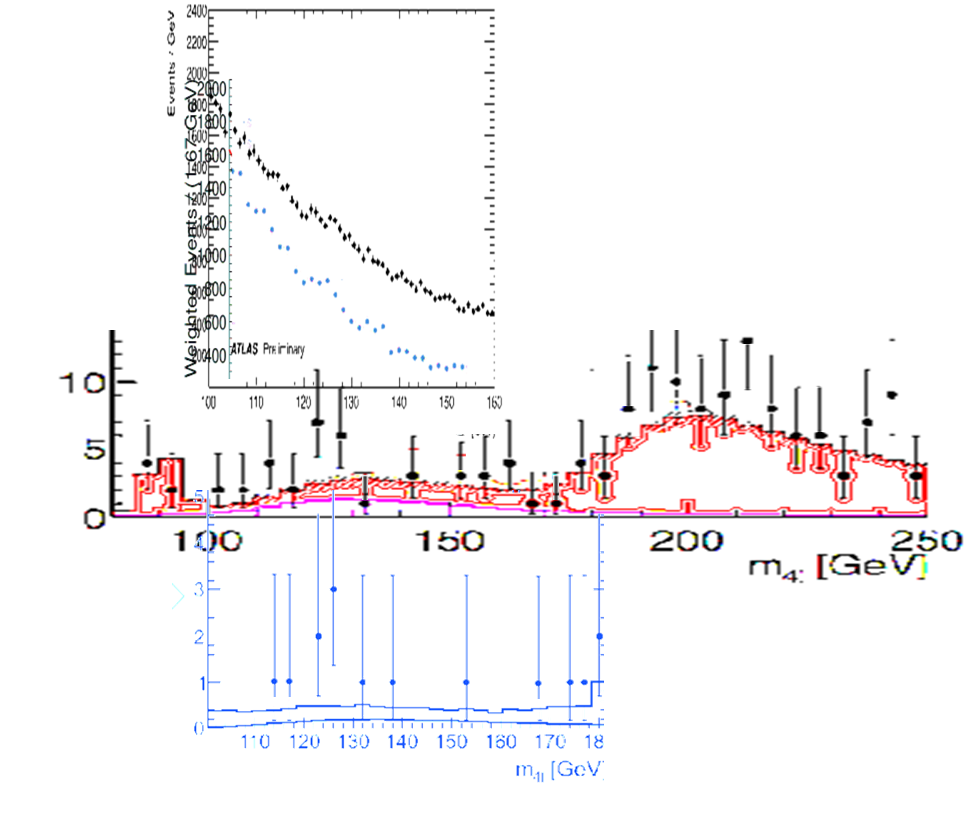Matt Strassler [July 6,2012]
Here’s the data that convinced the world of particle physics that a new particle, with a mass of 125 GeV/c2 (about 133 times heavier than a hydrogen atom), has been discovered at the Large Hadron Collider [LHC] by the ATLAS and CMS experiments.
I have explained elsewhere how the simplest type of Higgs particle (the Standard Model Higgs) is produced, how it decays, and how it can be sought and studied, and you might want to read these articles if you don’t follow what I’m saying.
Let me start with an oversimplified description of what studies were performed by ATLAS and CMS (the two general purpose detectors at the Large Hadron Collider [LHC]) to make this discovery. I’ll fill in some of the missing pieces at the end, but as we’ll see, they barely matter for the actual discovery. These are precisely the studies I described in my video clips from a talk for the public, which you might enjoy watching.
Among the several ways to search for the Higgs particle, the two easiest and most straightforward to interpret are:
- Look for Higgs particles, produced in any fashion, that decay to two photons (particles of light)
- Look for Higgs particles, produced in any fashion, that decay to two charged lepton/anti-lepton pairs… and focus only on the easily measured leptons: electrons and muons. For shorthand, we call this “four leptons.”
At both ATLAS and CMS, the experimental results are completely dominated by these measurements.
The measurements are (leaving out dozens of subtle details) simple:
- take all of the proton-proton collisions in which two energetic and well-separated photons are produced,
- measure the energies and directions of motion of the photons,
- use them to compute the invariant mass of the two photons,
- plot the number of collisions as a function of the invariant mass.
If a particle of mass M that decays to two photons is present in nature, the plot will show a bump (from the new particle) at the invariant mass M, sitting on a rather smooth background (from other, random processes that can produce two photons); if not, the plot will be rather smooth. It won’t be perfectly smooth because of statistical jumps up and down, though those jumps will become (relatively speaking) smaller and smaller as more data is taken. Then do exactly the same thing for the four lepton data. If you see a bump in both plots, and the bumps are at the same mass M, that’s evidence that you have a new particle decaying both to two photons and to four leptons.
Without further ado, here’s the data (these plots show the combined data taken in 2011 and 2012.)


You see there are four bumps, one in each plot, and they are all lying within a GeV of one another. The chance of this is obviously very small. You can imagine one, or even two perhaps, of the bumps is due to a mistake or a fluke, but to have both experiments have two mistakes or flukes that sit in the same location is very, very unlikely. In fact, to have even two bumps in the same location is unlikely. In short, both experiments have strong evidence, and thus each one can be viewed as confirming the other.
You can also look at the 2011 data and separately look at the 2012 data. Unfortunately not all the relevant plots were shown, but you can use the plots that show the probability of a fluctuation of a given size to compare the two years, see below. If you viewed (as I suggested in an earlier post) the 2011 data as telling you that there couldn’t be a simplest Higgs anywhere except near 125 GeV/c2, thereby removing any look-elsewhere effect, and the 2012 data as telling you whether there was an effect in that location, you would still be convinced.

No matter how you slice and dice this data, it looks good. And additional confidence comes from the fact that these measurements (unlike those from last December) were done with the signal region near 125 GeV blinded, until a couple of weeks before the announcement. That doesn’t mean no adjustments and improvements were made afterward, but all of the peaks were first seen when the data was unblinded.
Then there are the more difficult searches, for Higgs decaying to bottom quark/anti-quark pairs, to tau lepton/anti-lepton pairs, or to a lepton, anti-lepton, neutrino and anti-neutrino (again, `lepton’ means just electron and muon here). ATLAS did not feel comfortable releasing any of their other searches; only their 2011 studies are available as yet. That will change. But CMS did release new results. For both experiments, none of these searches show as much of a signal as one would naively expect from a simplest Higgs; maybe this means the Higgs isn’t the simplest one — or maybe it is just an effect of low statistics and other problems with these difficult searches.
Note also that the Tevatron experiments CDF and DZero also have data suggesting that the process quark + antiquark –> W + Higgs or Z + Higgs, followed by a Higgs decaying to bottom quark/anti-quark pairs, does indeed occur. This would tend to counter suggestions that the data from CMS and ATLAS might be showing that this new particle doesn’t interact with bottom quarks and tau leptons.
But to some extent, for the discovery of this new particle, none of the more difficult searches mattered at all — as I always suspected would happen. The only searches needed for the discovery of this new particle were the two easy ones, and the others, though they might have provided supporting information, played no role. And that is a good thing. Had the more difficult searches been essential for this claim of discovery, all sorts of questions about their validity would have been raised — including questions of unconscious bias and other related influences both within the two experiments and between them. The result would have been much more controversial. It is the fact that we have four clean bumps, one from each of the easy searches by the two experiments, that gives me, and everyone else in the field, confidence that a new particle has been discovered — one that is consistent with a Higgs.
A commenter quite reasonably asked me to put up the data without the bumps that guide the eye; here it is, very ugly but I had to modify the plots myself by playing games with color etc. The bumps in 4 leptons are easy to see; the bumps in 2 photons require you fit the data to a smooth curve and look for an excess in some region, which can be a bit hard to do by eye.



36 Responses
written. You wish it would never end. The closer it gets to the smaller side of the pages, the slower you
Oakley Jawbone Sunglasses http://www.ebuyaccessories.com
I suppose levitating a car is probable too?
Yes I know. I mentioned a factor of about 3 two posts above, so we agree on that. Systematic errors are very difficult to estimate, my experience is that its a bit of a black art, no matter how much ‘care’ you take. I wouldnt trust any measurement when these are ‘hard to beat down’. But we can short circuit all this by noting simply that the WW channel is stated in both groups literature as being equally as sensitive as gam/gam at 125GeV, with a SMH signal expected at 2.2 sig. Since this agrees with my statistical calculations I think they are essentially what its all about. Currently the WW signal shows no ‘peak’ like the ZZ and gam gam, and perhaps this has something to do with why ATLAS has developped doubts about it half way through the season.
It is funny to compare this to a year ago when many people (Tomasso being one) were calling the 140 GeV signal in the WW a very likely Higgs, and I was writing (you can check, its on your site) that without a signal in the gam gam, it is not. I think the response I got then from a few people was that the WW is the most sensitive channel, and we wont see anything in gam gam for another year. Now its the opposite.
I guess there is not very much more we can say now. But I think the situation is such that either there will be a clear signal in 3 channels towards the end of the year, and Peter Higgs and his 1964 weekends work will have to be counted as something akin to Einsteins and his 1905 paper, or there wont be, and so whatever this is, it is not Peter Higgs boson. There is also currently a second signal almost reaching 2 sig in the gam gam at 135GeV. I wonder what will happen to that.
OK, but the sources of the systematic errors remain the same as you go from 150 to 125 GeV. I do not see why these would suddenly become that much more significant for what is a 15% change in invariant mass translating to an equivalent change in cascade energies etc. If this is so my analysis is relevant.
The sources mostly remain the same, but as you go from 150 to 125 GeV, the signal becomes smaller (because the branching fraction of the Higgs decaying to two leptons and two neutrinos times the Higgs cross section drops by about a factor of 2.5, I think), and also the lepton energies and missing momentum from the signal become smaller (since the Higgs is lighter), and both of these mean that the systematic uncertainties become a bigger problem.
If this is ATLAS’s explanation I dont really buy it. Firstly they do not know the signal is at 125GeV a priori, above about 130 GeV WW is the dominant channel by ATLAS own data from 2011. All potentially significant channels need to be considered on an equal footing (which they are of course in the combined data). Not releasing the WW data suggests the experimentalists have at the very least a bias towards the 125GeV results. Thats understandable, much money has been invested and people are impatient. Just what can happen can be seen by looking at the 1 fb-1 data from 2011. One experiment has a 1 sig deficit at 125GeV, the other about 0. Now they have a 2.8 sig excess.
But their explanation does not stand up even if you accept the Higgs is at 125. The WW vs invariant mass cross section changes by only about a factor of 3 from 150 GeV to 125 GeV (I believe the graph even appeared in one of their talks). The expected Higgs signal at 150 GeV (with their cuts) from ATLAS 2011 plots is 23 events, vs a 43 event background for 1 fb-1. At 5 fb-1 for a 125 GeV Higgs this translates to an expected 2.2 sig signal, and this is supported by comments I read elsewhere. Thus the expected signal to noise is about the same as in the gam gam channel. The unreleased data on the WW show about 0.8 sig from CMS, and ATLAS is not saying. Have they decided to change the cuts in the WW channel? Why? Is it to improve agreement with the other channels? So I think the results look a bit mixed at the moment as far as the detected particle being a Higgs is concerned, which is the main thing interesting most people.
You’re only calculating the statistical error in your estimates. But the dominant errors are systematic. Those have to be beaten down with very great care.
The ATLAS WW analysis will appear very soon. They simply didn’t get it done in time… don’t forget there were only two weeks between the end of data taking and the presentations.
Some will remember that in 2011 it was the WW channel that was driving the excitement about a possible Higgs in the CMS/ATLAS data. Now ATLAS does not feel ‘comfortable’ releasing data in this channel. I suppose they would justify it by the uncertainty of the missing momentum. However this was not their position last july. If a signal is lacking in this channel this is not the Higgs, no matter how many sig are in the gam_gam channel. If so, (this now almost certainly new ) particle, doesnt answer any questions, but merely poses a new one.
Well, it is true the two experiments got burned in the WW channel last year. But also,that was in a mass range where the signal wasn’t so much smaller than the background. For a Higgs with a mass of 125 GeV, the signal is now a lot smaller relative to the background than it was for a mass of 140. So you bet they are being careful — not because they got burned, but because the measurement is really, really, really hard. I just had a 30 minute conversation about it this morning.
From your article about the decays of the SM Higgs, it looks like the H -> 2 photons is one of the rarest possible decays. Why is it that both experiments look for that decay? Thanks.
This is explained in the following article, out of date in its details but not in its descriptions of the strategies. http://profmattstrassler.com/articles-and-posts/the-higgs-particle/why-the-hints-of-higgs-currently-rest-on-uncertain-ground/
Also relevant: http://profmattstrassler.com/articles-and-posts/the-higgs-particle/why-is-it-hard-to-find-the-higgs-particle/a-lightweight-standard-model-higgs-particle/
Prof, when you get some time, would you please help me understand (1) what exactly is a quantum fluctuation, and (2) how is it a consequence of (or can be explained by) the Heisenberg Uncertainty Principle? Thanks.
Quantum fluctuations are such a basic part of quantum mechanics that it really requires an article; not something that can be done in a short comment. Someday I’ll explain it, but it may be a while; the list of things needed on this website is long.
The media reports that the LHC has discovered the Higgs and that the noble prize will shortly follow. So I can see the 5 sigma result means without doubt a new particle has been discovered, but is it possible to quantify how certain physicists are that this really is the long sought after Higgs boson?
Could this not be some other particle decaying into two photons or four leptons. An excited state of the Z or some other particle perhaps. After all if the LHC hadn’t found this particle, then the LHC would have continued to search for a BSM Higgs elsewhere.
Quantifying certainty isn’t possible. Each person has his or her own opinion. But the real question is how soon can measurements rule out this or that alternative… either that this is not a Higgs particle at all, or that this is not a simplest Higgs (i.e. a Standard Model Higgs).
The LHC will continue to search for a Beyond-the-Standard-Model (BSM) Higgs elsewhere.
The media reports that the LHC has discovered the Higgs and that the noble prize will shortly follow. So I can see the 5 sigma result means without doubt a new particle has been discovered, but is it possible to quantify how certain physicists are that this really is the long sought after Higgs boson?
Could this not be some other particle decaying into two photons or four leptons. An excited state of the Z or some other particle perhaps. After all if the LHC hadn’t found this particle, then the LHC would have continued to search for a BSM Higgs elsewhere.
Can we be sure yet that this 125 GeV particle is a scalar? How is the spin of the particle determined? Does it require the spin of all its decay products to be measured?
We cannot be sure it is a scalar. It will gradually become possible to measure the spin in decays to two lepton/anti-lepton pairs, by looking at the distribution of the angles between the four particles. The CMS talk refers to this indirectly (the “MELA” method.)
Thanks for the answer!
Hello Matt,
You will have noticed by now that I really like the Standard Model and a 125 GeV Higgs is all I could ever ask for (Nima Arkani-Hamed wrote in a presentation: As many people have remarked, a Higgs mass of about 125 GeV seems almost maliciously designed to prolong the agony of Beyond Standard Model theorists ….)
However, what still bothers me a bit is that if you look at the data without all the drawings it doesn’t look that convincing. What do you think? Do you have the nerves to show the plots without the drawings? I still think that the statistical analyses are correct but the data points in a plot aren’t too convincing to be onest.
Added.
Thanks Matt, that was a lot of work! To be honest I don’t know what to think of it. Especially if you take out all the drawings, also the background plots. Looking at the data you do get the feeling “I think we have it” but to my humble opinion we still need more data and further data analyses also because we know there is a awful lot of data selection going on. At the same time I know how skilled the CERN scientists are, so I trust in them and you!
Well, it was a good exercise. You can see that if the evidence had been much less you would have had a lot of trouble buying it. And also you see how important it is to fit the background for the photons in making the bumps clear — that “sideband” information IS used.
Also, you can’t really take out the background plots for the four-lepton case. That information IS needed so that you know that the background is flat in that region and so you know roughly how large it is. I’d have less confidence in the results if I didn’t know that.
There’s one more point; I’d feel better if ATLAS’s photons shifted to the left by half a bin. Their peak is a little higher than CMS’s peak, not by so much that I worry but enough that somebody’s photons are probably slightly mis-calibrated. Calibrating photons to 1% is challenging, so we may see some shifts by half a GeV before the results are made final.
I looked this over carefully today. I think actually the data does not support this as much as the statistical argument would make you believe; look carefully at the different tau measurements and think hard. You can’t just take statistical statements at face value, you have to look at where they come from — and this one is particularly problematic.
Isn’t interesting that a SM Higgs at 125 GeV is ”excluded” at almost 95% confident level by the CMS search for h->taus? As far as I understand an explanation could be that the bkg might have somewhat fluctuated (and in fact the sigma/sigma_SM looks negative for this channel). But still it’s an intriguing fact (next to the h->gammas somewhat larger cross-section), no?